Let's take apart the carb |
| 1 |
|
Remove the stud for in the center of the carb
for the air filter housing. |
| 2 |
|
Loosen the tiny set screw for the choke linkage
(use the tiny allen wrench). |
| 3 |
|
Remove all the screws around the perimeter and
top of the carb which hold the top plate to the rest of the
carb. There are a total of nine screws as follows:
- 5 of the same length on the perimeter of
the carb
- 2 of the same length as the 5 above "inboard"
from the edge of the carb; one is between the primary and
the secondary, the other on the outboard side of the secondary.
- 2 longer screws (of the three screws holding
on the "cover" piece with the right-angled tube; #134 in
Haynes exploded view).
|
| 4 |
|
Remove the third, smaller screw from the "cover"
(#134), set it and the "cover" aside. |
| 5 |
|
Slide the choke linkage apart so the long rod
is free from the mount to the choke plate. |
| 6 |
|
Loosen the captive bolt from the center of the
carb (accessible through the hole from which the stud was removed
above). |
| 7 |
|
Lift off the carb cover assembly. |
| 8 |
|
Remove the gasket between the carb cover assembly
and the bedplate |
| 9 |
|
Position the carb with the primary/secondary
toward you; then the primary will be on your right and the secondary
on your left. |
| 10 |
|
Remove the bolt at "1 o'clock" above the primary. |
| 11 |
|
Remove the idle air jet at "12 o'clock" above
the primary. Mine was labeled "125" |
| 12 |
|
Remove the bolt at "12 o'clock" on the perimeter
of the carb. It may have a BMW tag or hold a bracket for the
connector which goes to the electrical shutoff valve. |
| 13 |
|
Remove the wire from the terminal of the electrical
shut-off valve. |
| 14 |
|
Remove the bedplate of the carb from the float
housing. NOTE: There's likely a bunch of gasoline in the
float bowl, no need to tip over the base of the carb just yet
. |
| 15 |
|
Remove the gasket between the bedplate and the
float housing. |
| 16 |
|
Remove the primary air correction jet (which
unscrews) and emulsion tube (which falls out). My primary air
correction jet was labeled "100", the emulsion tube was labeled
"6S". The emulsion tube has a notch in it to make sure it is
oriented correctly and looks different from the secondary emulsion
tube. |
| 17 |
|
Remove the secondary air correction jet (which
unscrews) and emulsion tube (which falls out). My secondary
air correction jet was labeled "120", the emulsion tube was
labeled "4N". |
| 18 |
|
Remove the screw for the linkage to the accelerator
pump. Remove the part of the linkage which passes through the
carb body. |
| 19 |
|
Flip over the bedplate so you can remove the
float assembly. |
| 20 |
|
Remove the bolt which holds the float in place.
Remove the lockwasher and U-bracket. Remove the float. |
| 21 |
|
Remove the check valve for the float bowl
and the washer. This takes a 14mm deep socket.
NOTE: I never managed to remove the accelerator pump when
I did this, though I did remove the jet and washer at the
bottom of the pump to see why I couldn't get the pump out.
|
The secondary diaphragm |
| 22 |
|
Remove the three bolts and lockwashers for the
mount of the diaphragm to the carb body. |
| 23 |
|
Pull the sping/linkage as far from the diaphragm
housing and possible and rotate to free the linkage from the
rest of the carb (more obvious than it sounds) |
| 24 |
|
Remove the 4 bolts and lockwashers for the cover
of the secondary diaphragm. |
| 25 |
|
Remove the cover, note that there's a spring
on the inside - not under much tension. |
| 26 |
|
Look for the number stamped on the outside of
the diaphragm cover (should be "4"). Also count the number of
turns in the spring inside the diaphragm housing (should be
10). |
| Back to the
main part of the carb |
| 27 |
|
Mark (score in the metal) the orientation of
the automatic choke housing. Remove the automatic choke housing
by removing the 3 screws in the ring that holds the choke cover
captive. The tab which holds the wound spring-coil will slip
off and the coil will relax. The coil should stay with the carb
side of the auto choke, not with the cover. |
| 28 |
|
Screw the bypass mixture screw (the large one)
all the way in. Count how many turns out it was when you started.
|
| 29 |
|
Remove the bypass mixture screw (and rubber gasket).
|
| 30 |
|
Screw the mixture adjustment screw (the small
one) all the way in. Count how many turns out it was when
you started.
|
| 31 |
|
Remove the mixture adjust screw (and rubber gasket,
though mine was completely disintegrated). |
| 32 |
|
Unscrew the fuel shutoff valve |
| 33 |
|
Remove the vacuum line between the throttle butterfly
section and the float housing. It connects at the bottom of
the fuel inlet block and (looking at the bowl end) the right
side of the carb base. |
| 34 |
|
Remove the linkage from the choke. |
| 35 |
|
Remove the old bottom gasket (between the carb
base and the manifold). You may have done this earlier, but
I didn't. I found that the gasket was quite attached to the
base and I spent a fair amount of time scraping it off and cleaning
up this surface. |
| 36 |
|
Remove the turnbuckle-like linkage section to
allow you to separate the two sections of carb that remain.
|
| 37 |
|
Remove the 4 allen bolts and lockwashers from
the throttle butterfly section. Note which one is shorter for
reassembly; it's recessed further into the throttle butterfly
section. These hold the throttle butterfly section to the float
housing. |
| 38 |
|
Separate the throttle butterfly section from
the float housing. Remove the thick insulating gasket/spacer
from the parts. NOTE: Most of you should also have a gasket
above and below this spacer. Remove the gaskets and clean all
the surfaces. I didn't have one of these, which made my carbs
sad. |
Choke Diaphragm |
| There's a triangular
plate on top of the choke area. It's got a diaphragm in it that
is famous for failing. Mine were bad on both carbs. |
| 39 |
|
Remove the 3 screws on the top of the cover plate.
|
| 40 |
|
Remove the top cover, be careful to grap the
small spring when you do this. |
| 41 |
|
Remove the diaphragm (working the shaft clear
of the linkage in the choke housing as needed). |
| 42 |
|
Remove the gasket. |
Fuel inlet diaphragm |
| There's a very similar
diaphragm at the fuel inlet block. The diaphragms don't seem
quite as fragile, but you should certainly replace any rubber
pieces you can while the carbs are apart. |
| 43 |
|
Remove the 3 screws on the top of the cover plate.
|
| 44 |
|
Remove the cover and gasket. |
| 45 |
|
Remove the spring and the load cap that it sits
in (so it doesn't load the diaphragm directly) |
| 46 |
|
Remove the diaphragm. |
What now? |
That's all the disassembly
I did (or all I captured in my notes along the way). I'll
be happy to include any corrections from other folks who have
done this. I'm gonna try to go through the drawings I have
and add some more useful names to some of the parts.
I spent a fair amount of time (more than was needed from
a strictly utilitarian point of view) cleaning all the pieces
before reassembly. That included external pieces, de-sooting
the venturis, etc. Lots of volatiles were released. Don't
do this in a closed space. I had the big garage door open,
and the side door to get a breeze moving through. |
Done with the cleaning? Go to the reassembly
page |

